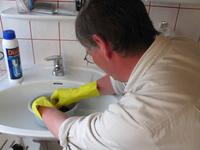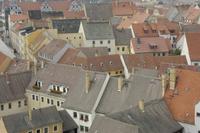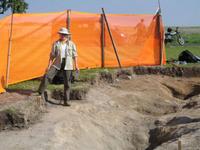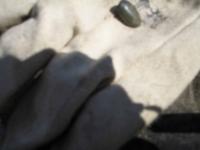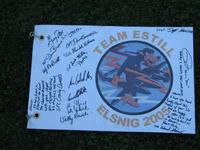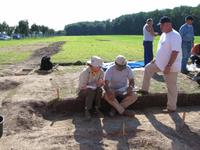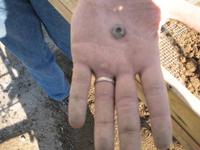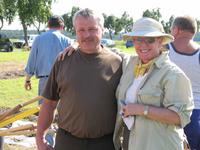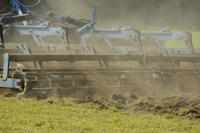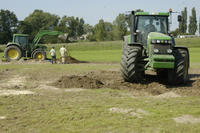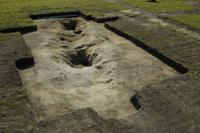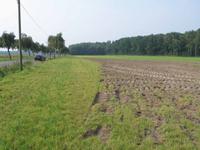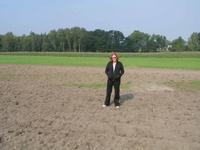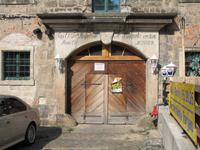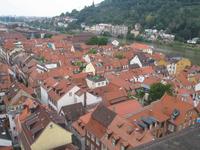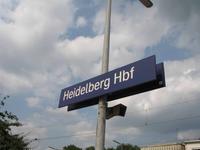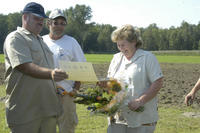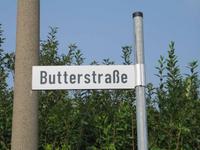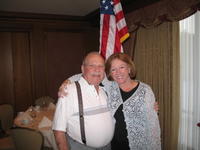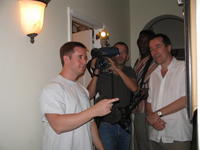Wednesday, September 20, 2005: I’m beginning to realize I’m not in Elsnig any more. My laundry has been washed in the machine (rather than nightly by hand..my mother would be proud and astonished at my domestic ability); papers are sorted and filed; my suitcases are back in storage (for a week); I don’t awaken at night wondering where the bathroom is in this hotel room; my desk is clear; thank-you notes have been written; Team Estill hats distributed; my summer clothes have been swapped for winter in tribute to a low temperature of 98; I have made the rounds of my favorite restaurants; I am drinking iced tea again every day; my dog and cat expect me to feed them now that they remember my true purpose in their lives; and 20 pounds of Haribo Gummi Bears have been divided and distributed (but for the Happy Cherries which are mine).
Last weekend I attended the 17th Reunion of the 474th Fighter Group in Salt Lake City and had lunch at the table next to Robert Redford at Sundance (he didn’t even ask me for an autograph or a photo - very polite guy in the presence of a German film star), and spent five days being filmed for a documentary (that’s the film star part). Though I barely have time to contemplate the impact of all I saw, felt, and did in Germany, I have begun an excavation of another kind - the discovery of feelings and conclusions. It’s hard not to get mired in the minutia of daily living and resort to “thinking about it” without writing about it. Toward that purpose I will continue, as events unfold and are relevant, to share them with you in this space.
THE REUNION in Salt Lake City was the perfect venue in which to tell the story of the Elsnig field and to connect with the people who knew my father then, and who were there when he left on his last mission. The connection I have with my adopted fathers of the 474th is precious and strong. For me, this reunion brought comfort, joy, and that undeniable sense of being loved, validated, and supported. If I ever doubted that this story must be told (and I still do for at least an hour every day), I was reminded as I spoke to the group on Friday night, that this story isn’t just mine but is part of a collective history and is a tribute to everyone who knows the impact of war.
Salt Lake City is beautiful, the air crisp and clear, and the landscape astonishing. The Little America Hotel has the name that makes the enormity of the apartment-size rooms a surprise. Maybe I’ve spent too much time in European hotels, but this place is huge. There were a few less than 200 of us in attendance. Honorary Dad, Lloyd Wenzel, our secretary, speaker, and organizer-rainmaker, told us that the original reunions were attended by more than 600 people. When I found the group in the very early 1990’s, I was greeted then by 150 of my “adopted” dads from the 428th squadron.
This reunion, like all the others, was sweet and inspiring. The stories are still poignant, their step is a bit slower, but they remember how it was then and probably how, to this day, to fly a P-38. Making a presentation to this group was a humbling experience. Despite the presence of lights and cameras, I was able to give them an overview of our work at Elsnig, to invite them to attend my father’s memorial service at Arlington next year, and to see and touch the labeled parts from my father’s plane. As they listened, I sensed my father’s presence in the audience along with his squadron friends who are not longer with us. I was truly in the presence of angels.
I spent the majority of my 10-hour flight home from London preparing 42 Powerpoint slides and an introduction written as the story of my father’s last flight based on what we learned in the field. I also read them Tom Wolf’s poem, The Right Stuff. Though I hoped they would like the story, I had no idea to what extent I would be affected. They provided me the opportunity to speak for my father. This is a rare and precious gift.
The good news about having the Der Spiegel crew with us at the reunion is that they were able not only to conduct interviews with three of the men who flew with my father, one of whom was his squadron leader on April 13, 1945, but to document the reunion. What I learned about documentary film making over the past month, is that this Der Spiegel crew are exacting, professional, and energetic artists. Except that I had to “enter” the reunion at least three times after I’d already been there a few hours, and that they taped my entire presentation along with most of the hugs I received and bestowed, it was a curious but interesting experience.
On Saturday, several of us went to Sundance, home of the film festival and Robert Redford. I joked with the film crew that I would be away for the day at Redford’s place and if I didn’t return in time for the grand banquet that night, they would know why. Considering my father’s sense of humor at work in my life, why would it surprise me to actually SEE Robert Redford around Sundance? Why would I think it unusual that he was having lunch at the next table and why was I so certain that one day I WOULD have lunch with Robert Redford and we would be talking about the book I had written that would be made into a Sundance film? Considering the events of the past months, everything feels possible.
We left on Sunday accompanied by the Der Speigel TV crew who spent the next two days with me at home filming my collection of my father’s stuff, and the documentation of my search for and discovery of his crash site. They saw the copious evidence of a lifelong quest constructed from the same kind of dreams of lunch with Redford and bringing my father home.
When the crew came for dinner on Sunday evening, they wanted to interview my artist son, Justin, about a painting he did which represents his grandfather’s last flight. He painted it for me when I completed my doctoral dissertation in February, 2o02. It’s an incredible tryptic depiction in oil on canvas of his grandfather’s last flight which he graciously shared with Der Spiegel. As I listened, I was reminded of Justin’s deep connection to my father. They are similarly constructed of the same sweet material, build, and temperament. Justin has always brought a whisper of my father to my life.
Monday was a 12-hour day of lights and cameras. When I say that I have empathy for what film people, behind and in front of the camera, I do not exaggerate. What appears effortless in the finished product, is not only tedious but without patience, impossible. That’s why they have trailers, make-up,wardrobe people, and difficult personalities. I knew my part of the story is important to the film but getting there was sometimes less than linear or comfortable and something as simple as walking six feet down my own hallway, can take an hour. (Especially when I feel like I have marionette strings attached to my arms and legs and that I’m walking in clown shoes.)
A long day of filming ended with a formal and highly lit interview in which reporter, Christopher Gerisch, asked me harder questions than I have ever asked myself concerning the impact of my father’s absence in my life. I told him he would be a good therapist and was reminded of skill it takes to ask exactly the right thoughtful question to evoke the most meaningful response. I was grateful for the experience but exhausted from the sheer effort it took to consider my place in all of this while speaking in the most intimate way about my mother, my grandparents, my father who raised me, my children, how my father’s presence in my life has or has not affected my relationships with men, my hopes and dreams, my need to find my father’s crash site, how I feel about war, and about a hundred other things that I responded to with no memory of what I said. It felt like therapy with lights and no way out but through it. Nothing like being asked to conduct a little self-analysis for the German people to watch on Sunday night at the movies.
The finished documentary (with the memorial service at Arlington Cemetery to be added later), will be shown on German television five times at the end of January, 2006. Sometime thereafter, it will be sold for distribution in the U.S. market. Overall, it takes 1000 hours of film to arrive at the appropriate and perfect 5o show-time minutes. Hopefully, some of the 950 hours will include my abilty to walk and talk on cue.
Photos of the reunion are forthcoming. I wanted to get this posted before I leave for Olympia and my boat next week. Stars and Stripes called today for a preliminary interview which will be included in a story they are doing about JPAC. So, the interest continues and my work begins. Is there “closure” at the end of this? I doubt it. There will always be the memories, the experiences, and the fact that my father died in “the war.” If closure exists, it will be in the feeling of satisfaction that I gain from telling the world about my father’s sacrifice and knowing that his brief life has not gone unnoticed or unappreciated. For now…..
